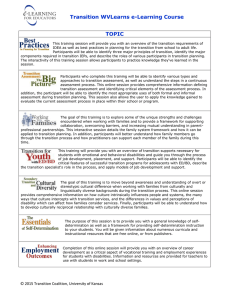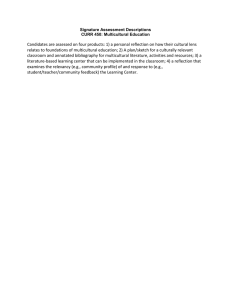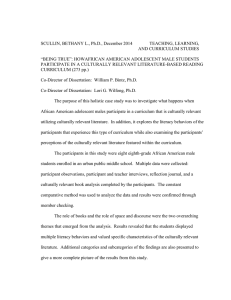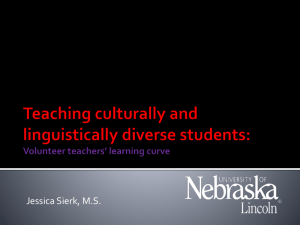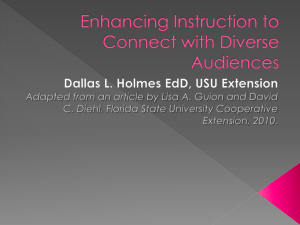Wofford-CRT-Capstone Summer 2011
advertisement
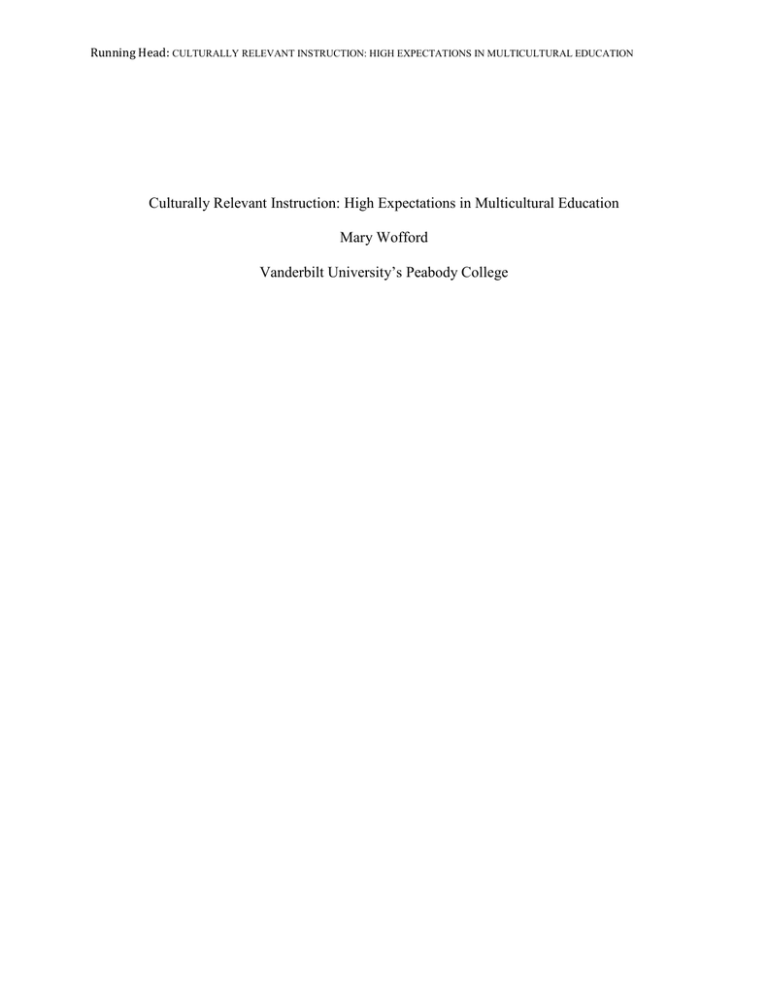
Running Head: CULTURALLY RELEVANT INSTRUCTION: HIGH EXPECTATIONS IN MULTICULTURAL EDUCATION Culturally Relevant Instruction: High Expectations in Multicultural Education Mary Wofford Vanderbilt University’s Peabody College CULTURALLY RELEVANT INSTRUCTION: HIGH EXPECTATIONS IN MULTICULTURAL EDUCATION Memo to Capstone Reviewers: Under the guidance of Dr. Rowe and Dr. Neal, my capstone paper has changed drastically from my initial proposal submission last fall. This paper also included a completely new reading list. 2 CULTURALLY RELEVANT INSTRUCTION: HIGH EXPECTATIONS IN MULTICULTURAL EDUCATION Abstract This paper explores the concept of culturally relevant instruction based mainly on the research and study of Gloria Ladson-Billings, Lisa Delpit, and Sonia Nieto. It explores the problems of the achievement gap and skewed teacher attitudes towards minority students in American schools. The paper makes an argument for using culturally relevant instruction. The main researchers vary somewhat in their definitions and use of the term “culturally relevant”, but all believe that when teachers have high expectations for students and bring in their outside experiences-especially language, the students will achieve more. Teachers must tailor their instruction so that students have access to the culture of power and are able to overcome low expectations that many in society have for them. Keywords: culturally relevant instruction, funds of knowledge, culture of power, student language, minority students, African American students, multicultural education 3 CULTURALLY RELEVANT INSTRUCTION: HIGH EXPECTATIONS IN MULTICULTURAL EDUCATION 4 Culturally Relevant Instruction: High Expectations in Multicultural Education Introduction The United States is in an educational turning point. Over thirty-five percent of students in school in America are of Hispanic or African-American descent. But, a quick glance into a public school faculty meeting will show that the teachers leading these classes do boast the same demographics. How and should teachers change their way of teaching to better reach the multicultural students in their classrooms? Is it possible for a classroom to be run in a way that prepares racial and ethnic minority students for academic, social, and workplace success? I would like to propose that modified teaching and curriculum can do wonders for the achievement of culturally diverse students, as shown in recent studies. Culturally responsive teaching, a teaching perspective that focuses on high student expectations and the valuing of the experiences students bring to school, can positively influence the educational well being of these students. In this paper I will look at some of the research that examines the theory of culturally responsive instruction, the effect it has on students in low-income areas, and how it is implemented in classrooms and schools. Through a greater understanding of ways the learner, classroom instruction, classroom assessments and the learning environment can be positively influenced by these practices, teachers can become more informed on how to utilize their students’ circumstances to create the best possible educational experience for all of their pupils. The Problems In order to create a solution, the problem of ineffective multicultural education must first be assessed. In countless schools, students are falling behind in literacy, math and science; in each of these subject areas various minority students are not improving. Specifically, students of CULTURALLY RELEVANT INSTRUCTION: HIGH EXPECTATIONS IN MULTICULTURAL EDUCATION 5 color and different ethnicities are falling behind their white counterparts because the students are not receiving the type of instruction they need to succeed. Research that examines those discrepancies while also analyzing solutions opens the way for teachers to consider changes that can improve the way they teach their students. Studies show that “the longer the African American students remain in school, the further they lag behind their white counterparts,” what is often referred to as the “achievement gap” (Lee, 2004, p. 78). This concept demonstrates the need for differentiated instruction among students in different racial categories, because a disconnect between curriculum, administration and students has occurred in schools and has contributed to the achievement gap. One problem is that African American students are often labeled “culturally deprived,” but are rarely seen as a distinct cultural group (Ladson-Billings, 2009, p. 10). According to Lee (2004), “There is longstanding research evident that race, language and class have severely restricted opportunities to learn for African American students” (p. 82). She asserts that these restricted opportunities come from restricted views of what is culturally acceptable in literacy and learning and are not limited to African American students. Other studies show that many students in American schools are part of “invisible minorities” (Nieto, 2000) in which their cultural groups are not verbally or visibly recognized by the school or teachers. Many of these students struggle in school and fall behind their white peers. One thing that contributes to the problem is the perspective that teachers have of the culturally “different” students in their class. Many teachers come into the classroom believing that the culture of their students is not a valuable asset in the classroom (Neito, 2000.) This attitude and perception crosses over into the way they instruct their students, and often keeps CULTURALLY RELEVANT INSTRUCTION: HIGH EXPECTATIONS IN MULTICULTURAL EDUCATION 6 them from equipping the students with valuable skills, knowledge, resources and social empowerment (Delpit, 2006). Part of teachers’ skewed perception of the value of diverse culture is shown by the way teachers react to students’ language and dialect. Ernie Smith, an African American professor, explains that his white teachers shunned any form of ebonics, calling the way he spoke “lazy” and “unintelligent”. Subsequently, he was turned off from school and formal learning (Smith, 2002). Views such as the ones Ernie’s teachers had can have detrimental effects on students. Only after teachers begin to understand these consequences can change take place. A Solution The theory of culturally relevant instruction is a significant addition to the world of education. It hopefully leads teachers and schools to solve the academic achievement problems for the many multicultural and diverse students in today’s schools. Several different educational researchers have defined culturally relevant instruction in a variety of ways. Seeing the perspectives of these researchers allows educators to draw ideas from and see the value of the theory in various ways and use culturally relevant instruction to best benefit the unique demographic in their schools. Gloria Ladson-Billings, Sonia Nieto and Lisa Delpit are three prominent researchers in the field of multicultural instruction and culturally relevant pedagogy, who, while they hold some similar beliefs in this area, have conducted studies looking at different ethnic groups: African American students, Mexican American students, and Latino students respectively. Culturally relevant or culturally responsive teaching provides a model for all students who are linguistically and culturally diverse but a vast majority of the research and implementation has CULTURALLY RELEVANT INSTRUCTION: HIGH EXPECTATIONS IN MULTICULTURAL EDUCATION 7 been done with African American students (Risko & Walker-Dollhouse, 2007). During this examination of these studies, I use Nieto’s (2000) definition of the word “culture.” She defines it as, “the values, traditions, social and political relationships, and worldview created, shared and transformed by a group of people bound together by a common history, geographic location, language, social class and/or religion” (p. 139). The researchers I examine in this paper follow a similar understanding of culture. Much of the research in this area suggests that students who are not of white, middleclass descent need differentiated instruction to meet their needs and help them achieve success both in and out of school. These research findings have the potential to help classroom teachers and administrators understand what problems they and their students are facing and how to combat these problems through improved classroom instruction, positive school attitudes, and welcoming classroom environments. While each researcher has her own take on the issues at hand, educators can adapt the research findings to fit their unique situations. Gloria Ladson-Billings studied successful teachers of African American students extensively and wrote several key pieces on the subject of culturally responsive instruction. In The Dreamkeepers, her book on successful teachers of African American children, she outlines some of the problems African American students face. She follows eight different teachers that she considers “dream keepers,” those teachers whose work with African American students helps them grow and become a part of the American dream. In Affirming Diversity, Sonia Nieto presents similar issues that other “multicultural students” face. She looks at twelve multicultural students, and examines their educational experiences. Lisa Delpit, on the other hand, in her book Other People’s Children, outlines the many educational issues that low-income black students CULTURALLY RELEVANT INSTRUCTION: HIGH EXPECTATIONS IN MULTICULTURAL EDUCATION 8 and several other minorities come up against. Delpit’s series of essays illustrates her research conclusions regarding the best ways to effectively teach these students. Nearly all of the statistics and stories presented by researchers such as these lead educators to recognize the need for a better-conceptualized education of those students who are being tragically left behind by some of their peers. Instead of waiting for parents or communities to change, teachers can take the first steps toward making educational enrichment a priority in theses students’ lives. In order to understand what these steps might look like, I will first examine what the researchers define as culturally relevant instruction and then outline the ways teachers implement this practice successfully in the classroom. One aspect of culturally relevant instruction that may be necessary to understand before beginning to implement this practice is Luis Moll’s term, “funds of knowledge” (Moll, 1992). He states that by “capitalizing on household and other community resources, we can organize classroom instruction that far exceeds in quality the rote-like instruction [that multicultural] children commonly encounter in schools” (Moll, 1992, p. 132). Most of Moll’s work involved working with students and their families while they were learning to speak English. Through his research he discovered that both the students and their families had extensive knowledge that could be used to contribute to the academic success of the students. When these “funds” were implemented in the curriculum being taught to students, they achieved great academic success (Nieto, 2000, p. 97). Moll (1992) explains that these students bring with them to school “ample, cultural and cognitive resources with great, potential utility for instruction” (p. 134). Thus, if the teachers begin to develop a deeper understanding of their students, they can tap into these funds and use them as a framework for instruction. It is important to note that while Moll’s theory of funds of knowledge can be seen as a basis for culturally relevant instruction, he is adamant that, CULTURALLY RELEVANT INSTRUCTION: HIGH EXPECTATIONS IN MULTICULTURAL EDUCATION 9 “funds of knowledge” should be considered culturally-based instruction. It is different in that it focuses on “essential household functioning” of people in a local region (Moll, 1992, p. 139). Culturally relevant instruction, as it is formally understood, seems to envelope the funds of knowledge that students bring to school along with several other important factors. Ladson-Billings’ (1995) article entitled “That’s Just Good Teaching! The Case for Culturally Relevant Pedagogy” defines it this way: Culturally relevant teaching [is] a pedagogy of opposition (1992c) not unlike critical pedagogy but specifically committed to collective, not merely individual, empowerment. Culturally relevant pedagogy rests on three criteria or propositions: (a) Students must experience academic success; (b) students must develop and/or maintain cultural competence; and (c) students must develop a critical consciousness through which they challenge the status quo of the current social order. (p. 160) According to Ladson-Billings, “cultural relevance” is not simply about teaching students based on the things they enjoy (2005). Instead, it is reaching students by investing in their culture. Ladson-Billings, who focused her research on African American students, says that “the primary aim of [a culturally relevant instruction] is to assist in the development of a “relevant black personality” that allows African American students to choose academic excellence yet still identify with African and American culture” (p. 20). That is, the aim of culturally relevant instruction is to create a teaching pedagogy that allows students to personally identify with the teaching, while choosing to invest in academics and academic excellence. It uses cultural referents to “impart knowledge, skills and attitudes,” (Ladson-Billings, 2000, p. 20), while giving students passion and empowering them in intellect, politics, and society. This allows them to develop the critical consciousness that will challenge the status quo. For many African American CULTURALLY RELEVANT INSTRUCTION: HIGH EXPECTATIONS IN MULTICULTURAL EDUCATION 10 students, this status quo includes low academic achievement and, therefore, their inevitable acceptance of a lower quality of life. Choosing academic excellence and success, developing cultural consciousness, and critically examining previously set expectations are the key features of culturally relevant pedagogy according to Ladson-Billings. While her specific research targets the African American demographic, other researchers agree with and implement these ideals for other demographics. Sonia Nieto (2000) affirms these tenets in her book on multicultural education. She writes, “When students’ cultural and linguistic backgrounds are viewed as a strength on which educators can draw, pedagogy changes to incorporate students’ lives” (p. 139). Components of Culturally Relevant Instruction Teacher Perceptions of Students In order to utilize these cultural referents, teachers must first be made aware of their perceptions of the various cultures of their students. Several of the case studies these researchers present display teachers who have unhelpful and negative perceptions of the students they are teaching. For example, one study in Ladson-Billings’s The Dreamkeepers offers a scenario of a student teacher who, while in the school’s teachers’ lounge, overhears the teachers discussing the differences between “white-blacks” and “black-blacks.” As they are profiling the students based on whether or not they “act white,” the teachers discuss ways the “white-black” are less trouble, and it is the “black-blacks” the student teacher should worry about (p. 21). Perceptions like this severely limit the teachers’ abilities to recognize the differences in their students’ cultural upbringings as an asset. Rather than using cultural difference as a classroom tool in this example, they see them as a detriment to the student, something the teacher feels she or he is responsible CULTURALLY RELEVANT INSTRUCTION: HIGH EXPECTATIONS IN MULTICULTURAL EDUCATION 11 for changing. The teacher in this example demonstrates her low expectations for the African American students in her class, depending on how “white” they act. Ladson-Billings (2009) explains how this negative perception is heightened by teachers who have an “assimilationist” perspective, the view that it is the job of the teacher to prepare students for society. As LadsonBillings (2009) explains, “If the teacher has low expectations, the place that the teacher believes the students ‘fit into’ is on society’s lower rungs” (p. 24). Teachers do not get to decide which students are worthy of certain “levels” of society. Believing that some students do not require or deserve access to all societal opportunities negates a teacher’s ability to educate students fairly. Good teachers maintain high expectations for all their students. This assimilationist perspective also comes into play when teachers, rather than blindly categorizing students based on race or religion, refuse to see differences in students’ cultures. In Affirming Diversity Sonia Nieto (2000) quotes one teacher who says, “I don’t see black or white… I see students as students” (p. 138). While this may sound fair, unbiased and ethical, it could actually lead to the opposite. Nieto points out that this “color blindness” often leads to a refusal to accept differences. Ladson-Billings (2009) explains that this is a way of “dismissing one of the most salient features of [a] child’s identity” (p. 38). She likens it to a teacher giving a gifted child, an ELL child, and a visually impaired child all the same work, without making any accommodations for their differences (Ladson-Billings, 2009, p. 36). It instead tries to force all students into a box, usually the box of what is called “the culture of power.” An Understanding of the Culture of Power The culture of power, the understanding that there is a dominant cultural group in place that dictates much of society, is an important concept necessary to understanding culturally relevant pedagogy. This concept should be acknowledged by teachers as a reality in their lives CULTURALLY RELEVANT INSTRUCTION: HIGH EXPECTATIONS IN MULTICULTURAL EDUCATION 12 and the lives of their students. The researchers discussed in this paper have differing views on how to approach this when implementing a culturally relevant or diverse pedagogy. LadsonBillings and Delpit take a reactionary approach. Ladson-Billings reminds readers and teachers in The Dreamkeepers that using culturally relevant instruction is not only about creating cultural empowerment by linking the instruction, literature and lessons of the students’ culture to the dominant culture, but should also be teaching students the importance of their culture in its own framework (Ladson-Billings, 2009, p.20). Delpit (2000) advocates for explicitly talking to students about differences in language and about the culture of power. She states, “I…believe that to act as if power does not exist is to ensure that the power status quo remains the same” (Delpit, 2000, p.39). She follows this up by explaining that she tells her students the same thing -- that a political and cultural game is going on and they must know the rules of both sides to be able to play. She concludes one section on the subject with the following thought: “[The students] must be encouraged to understand the value of the code they already possess as well as to understand the power realities in this country. Otherwise they will be unable to work to change these realities” (Delpit, 2000, p. 40). Sonia Nieto says less on the subject. She understands culture as a constantly developing entity that is not only held by the privileged, and implementing culturally responsive and multicultural education is a way of counteracting the assumption that culture is only for an elite or certain group (Nieto, 2000, p. 1410). Nieto, unlike Delpit and Ladson-Billings, does not appear to advocate for teachers explicitly teaching about the cultural power struggle as others do. An understanding of the culture of power, no matter the specific viewpoint on how it is taught in the classroom, helps the teacher understand several things about their students and about the curriculum. It can help put biases toward certain students or minority groups into a CULTURALLY RELEVANT INSTRUCTION: HIGH EXPECTATIONS IN MULTICULTURAL EDUCATION 13 new perspective and it can help educators evaluate the curriculum they are teaching and recognize biases and false assumptions. Whether teachers and administrators are moving away from these stereotypes and emphasizing that “equal is not the same,” or choosing to see all differences in students as assets to the learning environment, affirming diversity and diligently pursuing a multicultural perspective is what will change schools, students and communities. Characteristics of Culturally Relevant Teachers A synthesis of present research indicates what is known to develop characteristics of good culturally relevant teachers. In The Dreamkeepers, Ladson-Billings (2009) profiles eight teachers who exemplify excellence as culturally relevant instructors. She found these teachers through the mothers of African American students who deemed those teachers as successful with their children (Ladson-Billings, 1992, p. 382). The parents claimed that these teachers excelled in several areas of teaching. Each of these teachers implemented a curriculum in their classroom that followed culturally relevant pedagogy. That is, the teachers successfully encouraged students to choose academic excellence while maintaining a positive view of their culture and background (Ladson-Billings, 1992, p. 382). After analyzing their classrooms, Ladson-Billings came to the conclusion that the success of the teachers were not because of similarities in their teaching strategies, but rather the characteristics the teachers possessed and the attitudes they had about their students (1995, p. 162). Ladson-Billings (1992, 2009) effectively outlines the characteristics possessed by culturally responsive teachers. According to her study in The Dreamkeepers, culturally relevant teachers have high self-esteem and a high view of others. Thus, they believe all students can succeed and achieve better grades and stronger understandings of concepts. They see themselves CULTURALLY RELEVANT INSTRUCTION: HIGH EXPECTATIONS IN MULTICULTURAL EDUCATION 14 as giving back to the community and putting students back into the community to be agents of change, and they help students make connections between all their identities, including their classroom identity, their communal identity and their global and national identities. Culturally responsive teachers also set high standards for all of their students. Almost all of the research on multicultural education represented in this work agrees that successful teachers set high standards and high expectations, believing their students will achieve academic success. Additionally, Nieto and Delpit attribute teachers’ success to setting high standards and expectations for their students (Delpit, 2006; Nieto, 2000). Finally, these teachers do not see themselves as imparting knowledge to their students; rather, they view themselves as agents who “dig out knowledge” from their students, meaning they do not see the students as “blank slates” (Ladson-Billings, 2009). All of the characteristics of culturally responsive teachers are cultivated attitudes. A teacher’s choice of disposition, perspective and hard work influences their success with multicultural students. How Do We Do This? Classroom Implications In this section I outline the implications of this research for teachers and students in the classroom. Language, home literacy, and classroom environment are all major factors in education that can draw on culturally relevant pedagogy and that are key to understanding how to implement culturally relevant pedagogy. Recognizing how these issues play a role in students’ lives can lead one to draw conclusions about good classroom practices that will empower students on intellectual, social and cultural levels. What Should We Consider When Understanding Culture? Home language and dialect in the classroom. CULTURALLY RELEVANT INSTRUCTION: HIGH EXPECTATIONS IN MULTICULTURAL EDUCATION 15 One debate especially prominent in teaching circles of African American and black students involves cultural issues of language and dialect. Ernie Smith, in his chapter of Lisa Delpit’s The Skin that We Speak, entitled “Ebonics: A Case History,” describes the experience of many African American students in today’s schools. He explains how he grew up surrounded by “southern Black English,” which he then carried with him into school. The English he spoke was referred to as “broken English” or “slovenly speech,” implying a negative connotation of his language. Instead of being given tools and taught how to code switch or move between dialects, from standard English to ebonics and vise versa, he was written off as lazy and unintelligent. Ernie, now a teacher himself, has proven this to be an inaccurate judgment. He, like many others, learned to use the assumptions about Southern blacks and his home language to his advantage while selling street wares for money. Smith knew the value of his dialect and was smart enough to manipulate it for his benefit. Not until he heard one of his black role models give an eloquent speech in standard English did he realize that he could use this version of English without sacrificing his “blackness” (Smith, 2002). This case study presents a common negative attitude many teachers have toward language. The study conveys how the subsequent consequences affect students. That Dr. Smith had to learn the value of his dialect and the value of formal English only after learning on his own the value of standard speech should lead teachers to rethink current methods and perceptions. In a culturally relevant framework, educators embrace the home language and dialect of their students. They see their students’ unique cultures as assets to learning, and they realize that their students are coming into school with rich, eloquent and creative ways of speaking and thinking that they believe can be used for educational empowerment in the classroom (Delpit, 2006). CULTURALLY RELEVANT INSTRUCTION: HIGH EXPECTATIONS IN MULTICULTURAL EDUCATION 16 Gloria Ladson-Billings (2009) discusses the positive features of this language while also describing the need for her (black) students to have access to the “language of power.” She emphasizes how language and dialect can be a form of “cultural capital” for African American students that is often missed (Ladson-Billings, 2009, p. 19). Dr. Smith is an excellent example of the way language skills are often overlooked as assets and seen as deficits in the classroom. Effective ways for teachers to use home language and dialect to create a culturally responsive and positive pedagogy can be seen in these studies, for example, utilizing rap music to draw students in through their culture, affirming their creativity or opening a discussion about language and dialect. One very successful teacher in Ladson-Billing’s dream keepers study, Patricia Hilliard, used rap with her students to teach them the value of language and the concept that there is a difference between the way they speak and Standard English. However, the way that she chose to have the students re-write a rap song gave the students a valuable lesson about how their casual way of speaking (or rapping, in this case) was connected to Standard English (LadsonBillings, 2009, p. 91). According to Hilliard, this practice teaches the students how to shift their language, or how to code-switch (Ladson-Billings, 2009). As shown above, students and families are often discriminated against because of their home language and the dialect they speak. Lisa Delpit, in her book The Skin that We Speak, presents another valuable example in which Victoria Purcell-Gates wrote an article about a young boy and his mother from the Appalachian Mountains. Jenny, the mother of a young student, Donny, spoke with a strong southern mountain accent. His teacher claimed that Jenny was highly ignorant, an uninformed acknowledgement that led to various problems for Jenny and Donny. When Donny was failing his grade level, Jenny felt it was best that he be held back. CULTURALLY RELEVANT INSTRUCTION: HIGH EXPECTATIONS IN MULTICULTURAL EDUCATION 17 However, when she went to the administration to voice her concerns, she was quickly dismissed and her opinion was not taken into account. It was not until Dr. Purcell-Gates, who knew the family, approached the administration on their behalf that Jenny’s request for Donny to repeat a grade was heard. The problem was not only the school’s reaction to Donny’s speech and home language but also the implications this had on his actual schooling. Instead of seeing Donny’s local dialect as a flaw, the school could recognize the different culture behind his speech. In this example the school approached the situation from an assimilationist viewpoint. They were willing to pass Donny along even when he was not ready because they chose not to listen to his situation. When his mother came to advocate for him, they simply turned her away because they felt she was not capable of thinking critically or speaking about education. Both dialect and home language can play a significant role in giving underprivileged students the access they need to the language and culture of power. Lisa Delpit (2006) agrees that these features are an integral part of culture, the implications of which educators should consider more than they have in the past. She believes that students need to be taught to use and navigate the language of power so they can have access to economic resources and can make economic gains. One of her most powerful points here is that people need access to the language and culture of power so they can accurately speak against it and challenge it in favor of their home languages. The only way the status quo is going to change for the better is if different thinkers, speakers, and writers begin to effect positive change. Being able to teach in a way that challenges the status quo gives students access to the culture of power. Using CRT to Teach Students the Value of Language and Code-Switching Claiming that one adopt and abide by only the rules of the language of power would be a cruel and limiting view of culture. Instead of limiting students from different cultures, successful CULTURALLY RELEVANT INSTRUCTION: HIGH EXPECTATIONS IN MULTICULTURAL EDUCATION 18 culturally responsive teachers believe that students can learn to navigate in both discourses and receive double the language benefits (Ladson-Billings, 2009; Delpit, 2006). It is possible, as well as highly beneficial, to teach students to “code-switch” or effectively navigate between two dialects or languages. Delpit reminds us that there is a critical sequence involved in teaching this skill to multicultural students. Students must first learn the value of their heritage and their cultural way of speaking. Delpit offers an example of one successful teacher, Martha Demientieff, who spent many lessons teaching her Alaskan Indian students the value of their dialect of speaking, what she refers to as their “heritage language.” She taught students the skills they needed in order to switch between two different “versions” of English. As part of this teaching method, she emphasized the value of both languages. The students learned that their “heritage language” was a part of who they were and the culture they came from. The “formal” English, Demientieff taught them, was the version of English they needed in order to navigate through parts of the world outside their heritage (Delpit, 2006, p41). Demientieff’s series of lessons is a valuable example of a useful way to teach dialect differences. The way that she emphasized the value of both dialects or languages gave the students power – not just over the dialect they used on a daily basis, but equally over standard, or ‘formal’, English. She was able to create a sense of necessity and use for the dialects, which likely encouraged the students to apply their knowledge outside of her classroom- an ultimate goal of culturally responsive instruction. How a Culturally Responsive Approach Looks in the Classroom Researchers have different expectations about how culturally relevant pedagogy should be introduced in the classroom and what it should look like on a daily, lesson-by-lesson level. CULTURALLY RELEVANT INSTRUCTION: HIGH EXPECTATIONS IN MULTICULTURAL EDUCATION 19 Lisa Delpit (2006), for instance, is an advocate of skills instruction for students. She writes, “Students need technical skills to open doors, but need to think creatively and critically to participate in meaningful and potentially liberating work inside those doors” (p.18). Delpit suggests that skills instruction is the best possible way to prepare underprivileged students for the work force and the world outside of the classroom. In her book, she provides examples of teachers who are frustrated with the idea of whole-language literacy because they feel it does not give students access to grammar, correct spelling or other tools they will not learn anywhere else. They feel these skills are what gives them access to “standard” English, and therefore the language and culture of power (Deplit, 2006). However, not all researchers feel that skills instruction is the best practice for culturally responsive pedagogy. While Delpit would not even likely say that skills instruction is the best or only answer, she does advocate for it throughout her research. Ladson-Billings, on the other hand, seems to also appreciate a more whole-literacy approach. Several of the teachers in the Dreamkeepers study use whole-language approaches to teach reading. For clarification, the whole literacy approach focuses on building a curriculum around literature and texts. Knowledge construction based on texts and literature utilizes the over-arching concept of bringing the language, knowledge and understandings of the students back into the classroom in order to develop the instruction. This can be done well, as shown in the studies, by teachers using direct reading, or skills, instruction and also by teachers who are using a whole-language approach. Ann Lewis, a teacher in the Dreamkeepers study, used the book Charlie Pippin, a book about a young African American girl in wartime, as an anchor for her instruction. During the semester, she was able to draw the students in to the story of the African American girl by relating Charlie’s experiences to theirs, as well as use the current war CULTURALLY RELEVANT INSTRUCTION: HIGH EXPECTATIONS IN MULTICULTURAL EDUCATION 20 in going on in Iraq to build a deeper understanding of the plot, characters and themes of the book. By the end of the year, the students were bringing in new pieces of literature that related to their discussions, and were all highly engaged in learning. Students who were problems for other teachers in the past were succeeding at high levels (Ladson-Billings, 2009). On the other side of the spectrum, Julie Devereaux, a teacher that favors a more direct instruction reading method, used a basal reader where the chosen literature was used to develop skills. When questioned why she taught this way, Devereaux explained that the students themselves told her they couldn’t read-and that they wanted to. To help them learn, she employs a variety of methods. She pairs students to help each other, gives them old basals to take home and makes sure the class is supplied with high-interests books for them to read. She rewards the students with high praise when they try hard and when they succeed. By the end of the year, the students are all much better, on grade level, readers (Ladson-Billings, 2009). These two examples show that what is truly essential: taking the students’ experiences and schema into account, then creating the instruction based on those things. For successful teachers that were profiled, creating instruction in this way meant legitimizing student’s real life experiences and building instruction around relevant literature. Creating this instruction is a means of re-examining what counts as “literary” (Ladson-Billings, 2009). Successful teachers can challenge conventional scripts to develop literary tools that will validate the experiences of students by drawing on their knowledge of the students’ culture. Tools such as these are more meaningful and therefore useful in enhancing the literacy of the students. Questions and Conclusions CULTURALLY RELEVANT INSTRUCTION: HIGH EXPECTATIONS IN MULTICULTURAL EDUCATION 21 The research on culturally responsive instruction is growing. There are still areas that I believe need to be developed. One major area that I would appreciate reading more about would be the use of student assessment in a culturally responsive classroom. Much of the research I read discussed the use of curriculum and instruction in the classroom but left me wondering about how the teachers formally assessed their students. I would find it beneficial to read about how formal assessments enable them to better tailor the instruction to the needs of their students. There are many implications that may be drawn from this research. When the statistics of failing African American and Latino students seem bleak, educators can look to the work of Ladson-Billings, Moll, Delpit, Neito, and others for solutions. Culturally responsive teaching has proven its ability to raise student achievement in classrooms and enhance the educational value of the students in the classrooms. By using an approach that offers value to the lives, languages, and experiences of multicultural students, more students will experience success in than ever before. Teachers must make the commitment to evaluate the funds of knowledge their students possess as they enter school and make use of those in their instruction, choosing to carefully examine and reflect upon their instruction in light of their students’ experiences. Only when teachers do this consistently among their African American and minority students can changes begin to take place and open the way for more research and even better methods of instruction. CULTURALLY RELEVANT INSTRUCTION: HIGH EXPECTATIONS IN MULTICULTURAL EDUCATION 22 References Delpit, L. (2006). Other people’s children: Cultural conflict in the classroom (2nd ed.). New York, NY: The New Press. Ladson-Billings, G. (1992). Liberatory consequenses of literacy: A case of culturally relevant instruction for African American students. Journal of Negro Education, 61(3), 378-391. Ladson-Billings, G. (1995). But that’s just good teaching! The case for culturally relevant pedagogy. Theory Into Practice, 34(3), 159-165. Ladson-Billings, G. (2009). The dreamkeepers: Successful teachers of african american children (2nd ed.). San Francisco, CA: Jossey-Bass. Lee, C. D. (2004). African american students and literacy. In D.S. Strickland & D. Alvermann (Eds.), Bridging the literacy achievement gap, grades 4-12 (pp. 70-85 ). New York, NY: Teachers College Press. Moll, L., Amanti, C., Neff, D., Norma, G. (1992). Funds of knowledge for teaching: Using a qualitative approach to connect homes and classrooms. Theory Into Practice, 31(2), 132141. Nieto, S. (2000). Affirming diversity (3rd ed.). New York, NY: Addison Wesley Longman, Inc. Purcell-Gates, V. (2002). “…As soon as she opened her mouth!”: Issues of language, literacy and power. In L. Delpit & J. K. Dowdy (Eds.), The skin that we speak: Thoughts on language and culture in the classroom (pp. 121-144). New York, NY: The New Press. Risko, V. & Walker-Dollhouse, D. (2007). Tapping students’ cultural funds of knowledge to address the achievement gap. The Reading Teacher, 61(1), 98-100. CULTURALLY RELEVANT INSTRUCTION: HIGH EXPECTATIONS IN MULTICULTURAL EDUCATION 23 Smith, E. (2002). Ebonics: A Case History. In L. Delpit & J. K. Dowdy (Eds.), The skin that we speak: Thoughts on language and culture in the classroom (pp.15-30). New York, NY: The New Press.
